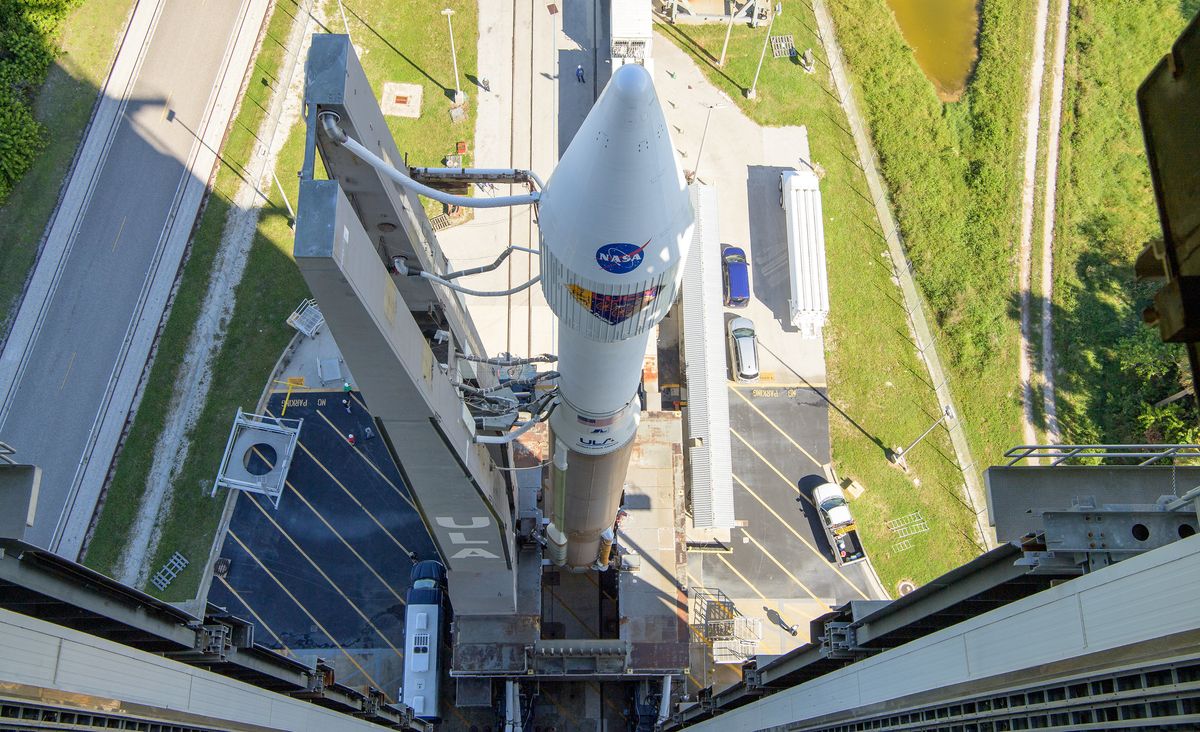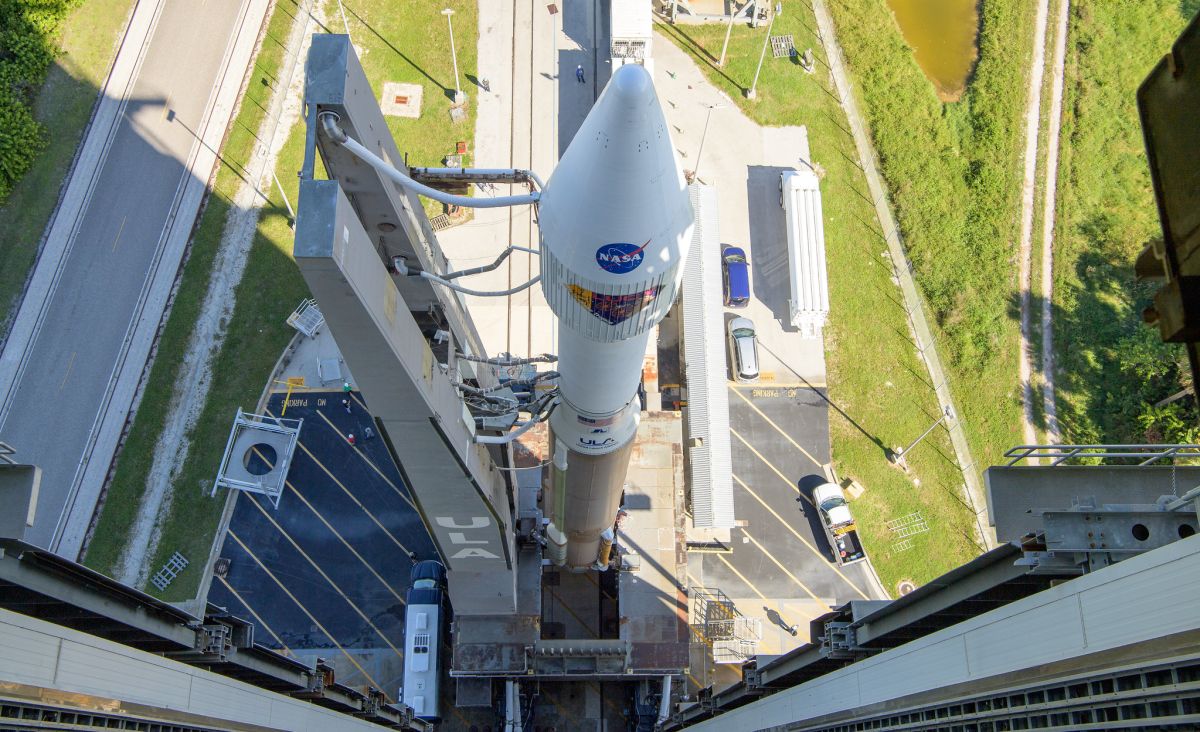
CAPE CANAVERAL, Fla. — NASA’s newest planetary science mission, an asteroid-observing probe named Lucy that will fly by a record eight different asteroids, is ready to launch and you can watch the action live online.
Lucy and its rocket are on the pad, after rolling out from their hangar on Thursday (Oct. 14). The duo, which stands 188-feet-tall (57.3 meters), is targeting an early morning liftoff on Saturday (Oct. 16) at 5:34 a.m. EDT (0934 GMT) from Space Launch Complex 41 at Cape Canaveral Space Force Station in Florida atop a United Launch Alliance (ULA) Atlas V rocket. Currently, with two days until liftoff, the weather forecast suggests just a 10% chance that poor conditions will interfere with launch.
You can watch the launch live here and on the Space.com homepage, courtesy of NASA TV. Liftoff is set for 5:34 a.m. EDT (0934 GMT). NASA’s webcast will begin at 5 a.m. EDT (0900 GMT).
Related: Meet the 8 asteroids NASA’s Lucy spacecraft will visit
Weather officials with the 45th Space Delta at Cape Canaveral Space Force Station have predicted a 90% chance of favorable conditions at liftoff. The only cause for concern is the potential for cumulus clouds. There are backup launch opportunities on Sunday and Monday if Lucy can’t launch on Saturday.
“Everything is progressing towards a launch on Saturday morning, and we’re incredibly excited to be a part of this mission,” John Elbon, chief operating officer for ULA told Space.com. “I can’t tell you how much it means to us that we’ve had the opportunity to partner with NASA and launch spacecraft to explore all of the planets of the solar system.”
Related: NASA’s Lucy asteroid mission will explore mysteries of early solar system
Lucy’s journey to the Trojans
The Lucy mission, which cost around $981 million, is NASA’s next asteroid-observing spacecraft. Armed with a suite of cameras and scientific instruments, Lucy will attempt to answer one of the solar system’s mysteries: how did the giant planets form?
The current leading theory is that Jupiter and Saturn formed first, closer to the sun than they are today, and that the rest of the planets formed from the leftover bits, and eventually settled in the outer solar system. What’s unclear is how the bits of rock and ice went from tiny pieces smashing into each other to the massive planets we see today like Uranus and Neptune.
Here’s where Lucy comes in: the spacecraft is set to explore two different packs of asteroids, each orbiting in the same path as Jupiter on either side of the massive planet. These planetary bodies, known as Trojan asteroids, range in size from a few kilometers across to hundreds of kilometers in diameter.
Scientists want to study the Trojans because they’re thought to be cosmic fossils, like time capsules from the formation of the solar system, and could be made from the same materials as some of the outer planets. As such, the rubble could tell us a lot about how planets formed.
Lucy will have five different encounters with a total of 7 Trojan asteroids over its 12-year mission; it will also observe one main-belt asteroid before it reaches the Trojans in 2025. The targets were chosen due to their diverse properties and particular orbits. As such, Lucy has the unique opportunity to visit more asteroids than any mission to date.
Lucy will be able to analyze each asteroid’s composition and other geophysical properties that could help scientists unlock the secrets of planetary evolution.
“One task is to map the craters across each asteroid’s the surface,” Cathy Olkin, Lucy deputy principal investigator at the Southwest Research Institute said during a prelaunch science briefing on Thursday (Oct. 14). “We’re going to look for craters smaller than a football field, about 70 yards across [64 m], for craters as large as four miles [6 kilometers], and everything in between.”
Olkin said that the size and number of craters on an asteroid’s surface can tell us a lot about its age, which in turn, can reveal clues about an asteroid’s origin and evolution.
Ride to space
Lucy will ride to orbit atop a ULA Atlas V rocket, which will fly in its simplest configuration: the 401. This most basic Atlas V consists of a 4-meter payload fairing, a single-engine Centaur upper stage and no solid rocket boosters. The flight will mark the 146th Atlas V mission to date and the 89th for NASA.
It will also mark the 100th launch from ULA’s launch facilities here at the Cape. SLC-41 has hosted a variety of missions carried by different Atlas V variants, and so far all have been extremely successful. Lucy is building on the legacy of the many missions that have come before it, including missions like the OSIRIS-REx asteroid explorer, the InSight Mars lander, and even the New Horizons spacecraft that flew past Pluto.
Related stories:
Lucy’s launch also marks a notch in the final countdown for the Atlas V rocket, which ULA is retiring in favor of the still-in-development Vulcan rocket. There are 29 Atlas V rockets left in ULA’s stable of launchers, and all of those have been assigned to missions.
Vulcan Centaur will be the workhorse of the future for ULA, and is due to launch in early 2022.
Follow Amy Thompson on Twitter @astrogingersnap. Follow us on Twitter @Spacedotcom and on Facebook.



